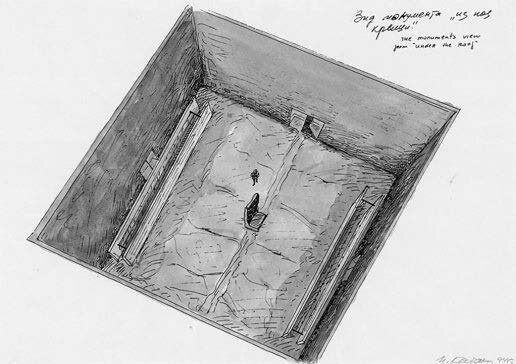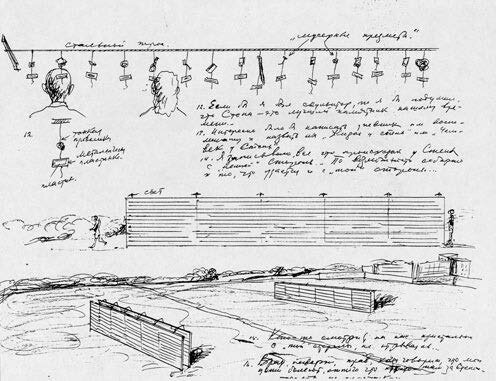Two Memories About Fear
YEAR: 1990
CATALOGUE NUMBER: 37
PROVENANCE
Collection of the artist
EXHIBITIONS
Ein Ausstellungsprojekt in Ost und West, Potsdamer Platz, Berlin, Germany
Die Endlichkeit der Freiheit, 1 Sep 1990 — 7 Oct 1990 (Organisation: daad- Galerie, Berlin)
Berlin, Germany
A project in Berlin as a rooted monument. This gave rise to a project variation in Darmstadt in 1994. This was followed by a project for a permanent installation behind the Hamburger Bahnhof, Berlin 1993
DESCRIPTION
The structure of the installation consists of two pairs of wooden walls running parallel to one another at a distance of 50 meters. The walls (made of new construction boards) are arranged along both sides of the line where the Berlin Wall once stood. This line is easily discernible because of the scraps of garbage lying around and the absence of grass. This symmetrical composition located partially on the Eastern side and partially on the Western side of Berlin is clearly visible in the empty space of the square. Both parts are identical and stand out from far away because of the freshly erected boards. The walls stand directly on the ground and are connected by metal wires. A corridor is formed between the walls with metal cables stretched along it at eye-level. Two people can easily pass through the corridor freely. Various garbage items hang on the cables at intervals of 20 cm. These are empty flasks, boxes, etc. Small placards are attached from below, containing texts on both sides. The texts consist of utterances of people from the Eastern and Western sectors of Berlin about what they think of the people on the other side of the wall. All the texts are filled with fear, suspicion, hatred. All the texts – there are more than 400 of them – are identical on the Eastern and Western sides. The wind blows the metal placard around so that they emit a chiming sound.
The viewer, walking between the two walls and reading the texts, can feel the atmosphere of that time, a time which is gone forever.
CONCEPT OF THE INSTALLATION
In April of 1990, a number of artists were asked to participate in the exhibit ‘Die Endlichkeit der Freiheit’ in Berlin dedicated to the destruction of the Berlin Wall. According to the plan, each artist could select for himself two objects, two places in former West and East Berlin, and find the interrelationship, the interaction, between them. The place I chose was called Potsdamer Platz. It was an enormous vacant lot through the middle of which ran that very same Berlin Wall, and after they had quite recently carried away the cement blocks which had comprised it, the clear line of that wall remained on the ground, not overgrown by grass, an intriguing and horrible outline dividing two worlds.
What occurred to me was the construction of a double installation along both sides of this line, on the East and West sides. On the outside, both parts had to be the same. Each represented two parallel wooden walls (2.73 meters high and 33 meters long) which formed a narrow corridor with an exit to either side. Metal cables were stretched inside along the entire length of the corridor at the height of a person, and approximately 250 objects were hung on them – different small pieces of garbage such as jars, nails, boxes, wire which were found right here on the ground near the former wall (accordingly, on the West side was ‘Western’ garbage, on the East side there was ‘Eastern’ garbage). Under each of the objects, hung on the cables in three rows, I arranged small rusty labels with fragments of utterances (of course invented by me) of residents living on both sides of the ‘Wall’ about what they thought about those living on the other side. As a rule, they are permeated with fear, mistrust, and horror, as though referring to creatures that are completely mysterious and unfamiliar and from which you could only anticipate the very worse at any moment. (We should recall and imagine the entire complete rupture between these worlds at that time, the atmosphere of the repressive fear and divisive ‘Iron Curtain’ which was manifested in Berlin in reality as the ‘Wall.’) The texts from the Western side were typed in German and English on two sides of the labels. But the exact same texts, absolutely identical, hung in the ‘corridor’ on the Eastern side as well, only in German and in Russian. The viewers, walking along the ‘corridor’ of the Western installation and crossing over the former ‘border’ entered into the corridor of the Eastern installation and saw before them the same exclamations and the same state of the people uttering them. After this, the metaphor was easily decoded and did not require commentaries. As the viewer walked along the thirty-meter corridor, he felt squeezed in and hidden in this long wooden tunnel. Above was only a narrow strip of sky, and in the silence, only the clanging of metallic plates could be heard. (There was always wind in the tunnel, and the plates, swinging about, would hit one another.)
The specific effect of these two lonely, wooden walls was envisaged at night as well. In the evening, each installation was locked from both sides with an iron gate, and inside lamps were turned on, six in each of them. This created a strange effect – two illuminated empty corridors on an empty black square, slightly resembling the camp ‘trenches’ used by prisoners for walks…
Images
Literature









